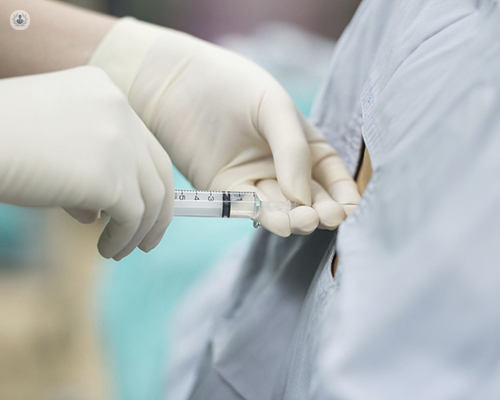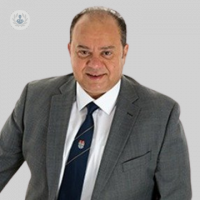Fluoroscopic guided injections: how technology delivers safer pain relief treatment
Written by:Pain medicine is one of the fastest-growing medical specialties. This is due to the fact that pain is now recognised as a condition in its own right that requires treatment. The advancement in technology has helped in the development of new techniques and equipment to deliver pain relief interventions, such as fluoroscopic guided injections.
Dr Yasser Mehrez, a leading consultant in pain medicine, explains how the use of fluoroscopy has considerably helped to deliver safer injections to alleviate pain.

What is a fluoroscopic guided injection?
Injection treatments have been widely used to relieve long-term chronic pain. This includes spinal injections to relieve spinal, visceral and various body pains. There are also injections and interventions to help with joint pain and soft tissue conditions.
Fluoroscopy is a type of medical imaging that produces images similar to an X-ray. The idea of using fluoroscopy started years ago to help the practitioner to safely confirm the intended location of their injections. These images can be dynamic to allow live monitoring of a procedure or still images to confirm that the target area has been successfully treated.
Using fluoroscopy has significantly helped to deliver safer treatments and reduce the overall risks involved. Because of this, interventions in pain medicine have significantly increased with more successful results. Most interventional pain procedures are currently done under fluoroscopy.
What type of treatments can I receive?
A fluoroscopic guided injection involves injecting medicine directly into an area of the body, such as joints, muscles and around major nerves. So, it’s possible to perform many types of interventions and injection treatments. Some of the procedures include:
- Radiofrequency denervation of the lumbar, thoracic or cervical facet and sacroiliac joints
- All forms of epidural injections
- Sympathetic nerve ablation
- Pulsed radiofrequency of the spinal nerves and knee, hip, wrist and shoulder joints.
Such treatments can significantly help with spinal, arm, leg, joints and nerve type pains.
How are the injections performed?
The patient would be positioned on a special X-ray compatible table in an operating theatre. The area of the body to be treated would be examined and then imaged using the C-shaped fluoroscopy device.
To make the procedure more comfortable for patients, we use local anaesthesia to numb the skin and intravenous sedation to provide a more comfortable experience for the patient.
We use X-ray guidance (fluoroscopy) to direct a very small needle into the targeted area. Once the correct position is confirmed, the medicine is injected, other nerve treatments can be applied and the needle is then removed.
Following injection treatments, the patient is observed in the recovery area for a short period to make sure that they have adequately recovered following the injection. After that, they can go home accompanied by a family member or friend.
How long do I have to rest afterward?
Most patients can resume usual activities on the following day. However, some patients can resume activities immediately following injection treatment as per the practitioner’s advice.
Dr Yasser Mehrez is a leading consultant in pain medicine, anaesthesia and intensive care based in Milton Keynes. To make an appointment with him, visit his Top Doctors profile today.


